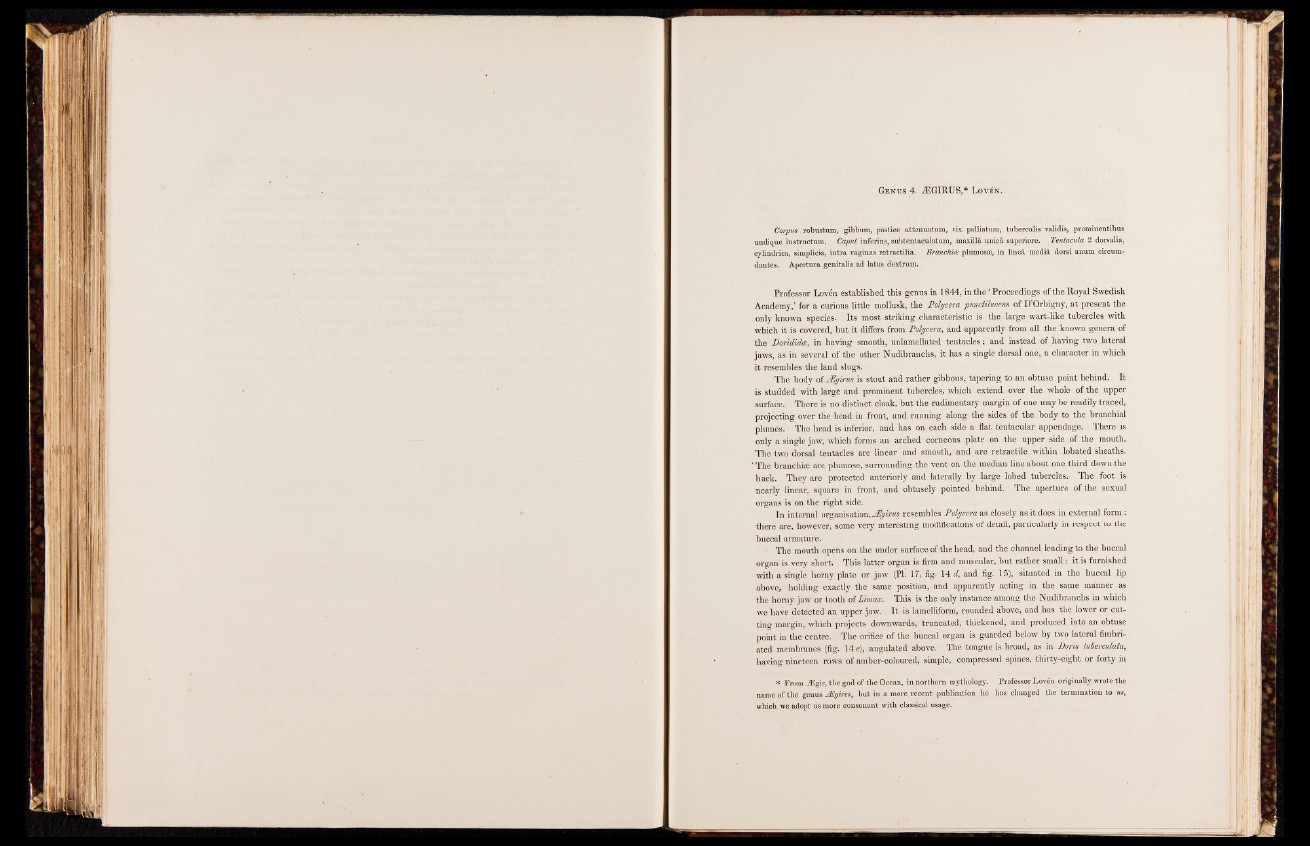
Genus 4. iEGIRUS,* Lovän.
Corpus, robiistum, gibbum, postice attenuatum, vix palliatura, tuberculis validis, prominentibus
undique instructum. Caput inferius, subtentaculatum, maxillä unicä superiore. Tentacula 2 dorsalia,
cylindrica, simplicia, intra vaginas retractilia. Branchia plumosse, in lineä mediä dorsi anum circum-
dantes. Apertura genitalis ad latus dextrum.
Professor Loven established this genus in 1844, in the ‘ Proceedings of the Royal Swedish
Academy,’ for a curious little mollusk, the Polycera punctilucens of D’Orbigny, at present the
only known species. Its most striking characteristic is the large wart-like tubercles with
which it is covered, but it differs from Polycera, and apparently from all the known genera of
the Lorididce, in having smooth, unlamellated tentacles ; and instead of having two lateral
jaws, as in several of the other Nudibranchs, it has a single dorsal one, a character in which
it resembles the land slugs.
The body of JUgirus is stout and rather gibbous, tapering to an obtuse point behind. It
is studded with large and prominent tubercles, which extend over the whole of the upper
surface. There is no distinct cloak, but the rudimentary margin of one may be readily traced,
projecting over the head in front, and running along the sides of the body to the branchial
plumes. The head is inferior, and has on each side a flat tentacular appendage. There is
only a single jaw, which forms an arched corneous plate on the upper side of the mouth.
The two dorsal tentacles are linear and smooth, and are retractile within lobated sheaths.
I The branchiae are plumose, surrounding the vent on the median line about one third down the
back. They are protected anteriorly and laterally by large-lobed tubercles. The foot is
nearly linear, square in front, and obtusely pointed behind. The aperture of the sexual
organs is on the right side.
In internal organisation, JEgirus resembles Polycera as closely as it does in external form :
there are, however, some very interesting modifications of detail, particularly in respect to the
buccal armature.
• The mouth opens on the under surface of the head, and the channel leading to the buccal
organ is very short, This latter organ is firm and muscular, but rather small: it is furnished
with a single horny plate or jaw (PL 17, fig. 14 d, and fig. 15), situated in the buccal lip
above, holding exactly the same position, and apparently acting in the same manner as
the horny jaw or tooth oiLimax. This is the only instance among the Nudibranchs in which
we have detected an upper jaw. It is lamelliform, rounded above, and has the lower or cutting
margin, which projects downwards, truncated, thickened, and produced into an obtuse
point in the centre. The orifice of the buccal organ is guarded below by two lateral fimbriated
membranes (fig. 14 e), angulated above. The tongue is broad, as in Loris tuberculata,
having nineteen rows of amber-coloured, simple, compressed spines, thirty-eight or forty in
* From iEgir, the god of the Ocean, in northern mythology. Professor Loven originally wrote the
name of the genus JEgires, but in a more recent publication he has changed the termination to us,
which we adopt as more consonant with classical usage.